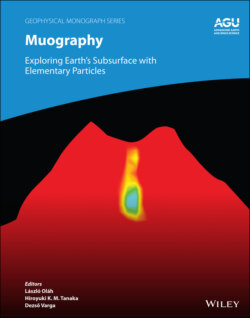Читать книгу Muography - Группа авторов - Страница 32
1.4 CONCLUSIONS
ОглавлениеThe investigation of the basic properties of the Earth has been an active area of research in the field of solid earth science and has been conducted using “intrinsic probes” originated in our planet, such as seismic waves and gravity. For example, seismic tomography revealed that the Earth has a layered structure composed of a core, mantle, and crust. In the 21st century, research may proceed by utilizing extrinsic probes, such as muons to solve current questions in solid Earth science. Researchers are currently investigating the possibility that new extrinsic probes may provide another method for carrying out surveys inside Earth and other planets.
Muography offers a unique opportunity to researchers for observations of the Earth. In particular, the following two features that muography offers were impossible with the conventional geophysical techniques: (i) a long and stable observation capability throughout the globe without any active source generation required, hence reducing the operational cost by using naturally abundant muon particles, a sustainable- and continuous cosmic resource and (ii) capability to measure the mass of hectometric to kilometric scaled objects with a greater precision than possible with any other preexisting techniques. On the other hand, the major disadvantage of this technique is that the measurements are limited to near‐surface depths and results are only obtained for the volumes located at elevations higher than the detector. However, one can take advantage of this disadvantage. Muography can specifically focus on the target volume located above the detector under a reasonable assumption of almost linear probe trajectories, and thus no model assumption is necessary inside the target volume unlike other geophysical techniques. If the distance between the detector and the target object (D) holds the following conditions:
(1.5-1)
(1.5-2)
the total mass (M) of the volume within the angle range, θ ±Δθ and ϕ ±Δϕ will be
(1.6)
where <X> is the muographically averaged densimetric thickness (MADT), and L is the typical thickness of the target object. Tanaka and Ohshiro (2017) discussed the total mass of the Egyptian pyramid. If the muographically estimated mass of the pyramid greatly differs from the conventional model, assumptions made about the human resources and time that had been required in Ancient Egypt to build the pyramids must be reconsidered.
Precise underwater and underground positionings are required for detecting crustal deformation under the sea caused by submarine or submerged volcanic and tectonic activities. These works have utilized the techniques of a combination of GNSS (global navigation satellite system) and the acoustic positioning system, ocean bottom pressure gauges, autonomous‐underwater‐vehicles‐based sonar bathymetry, etc. In particular, the acoustic positioning system has been widely used (Kussat et al., 2005; Viola et al., 2013). Fluctuations of the acoustic wave velocity due to the oceanic environment, e.g., variations in salinity, temperature, or internal density waves in the upper ocean, limit this technique's accuracy and dependability. More importantly, the acoustic technique requires an active source to transmit sound waves, making it difficult to apply this technique to long‐term monitoring. In general, cosmic-ray muons are relativistic particles as they travel at almost the speed of light through matter. Cosmic‐ray muons are ubiquitous and universal. By utilizing this universality and relativistic nature, cosmic muons have a potential to be used for positioning the detector located underwater or underground three dimensionally. The technique is called the muometric positioning system (μPS) (Tanaka, 2020b) and is expected as one of the future geophysical tools.
By exploiting extrinsic probes like muons, new targets of solid earth science that could not be investigated with methods such as seismic tomography will be possible to survey and great discoveries may result in these added capabilities. The basic concept of muography was originally developed between sixty and forty years ago. Already, the potential of these quantum tools, which exploit naturally arriving particles to better understand important topics in Earth science, is beginning to be recognized.
